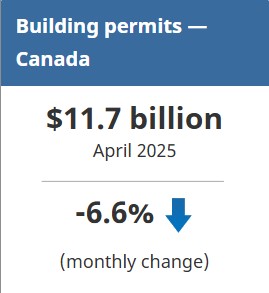Statistics Canada: Building Permits, April 2025

In April, the total value of building permits issued in Canada decreased by $829.6 million (-6.6%) to $11.7 billion. British Columbia (-$1.2 billion) led this decrease in construction intentions, which was mitigated by Ontario (+$299.3 million).
On a constant dollar basis (2023=100), the total value of building permits issued in April fell by 6.6% from the previous month and by 16.4% on a year-over-year basis, following a strong upward movement in April 2024.
Multi-family construction intentions weigh down residential sector
Residential construction intentions declined 11.6% (-$967.7 million) to $7.4 billion in April 2025. The multi-family segment (-$882.5 million) was the primary contributor to this decline, while the single-family component (-$85.2 million) contributed to a lesser extent.
The reduction in multi-family permit values was driven by British Columbia (-$837.4 million). The Vancouver census metropolitan area (CMA) (-$1.0 billion) drove the province’s decrease, after bolstering the national multi-family component’s increase during the first quarter of 2025.
The decrease in single-family construction intentions in April was most pronounced in Alberta (-$37.4 million) and was partially offset by Quebec (+$26.6 million).
Across Canada, 21,400 multi-family dwellings and 4,200 single-family dwellings were authorized for construction in April, marking a 6.5% decrease in the total number of units authorized compared with the previous month.
Ontario leads non-residential sector gains
The total value of non-residential building permits issued in April rose by $138.2 million (+3.3%) to $4.3 billion. Growth in industrial (+$186.8 million) and commercial (+$68.6 million) construction intentions was moderated by a decline in the institutional component (-$117.2 million).
Overall, the increase in non-residential construction intentions was driven by Ontario (+$352.7 million), while British Columbia (-$341.0 million) tempered the gain.
Ontario’s non-residential construction intentions rose sharply by 20.8% to $2.0 billion in April, led by the commercial component (+$259.0 million) and supported by construction intentions for office buildings in the Toronto CMA. Ontario’s industrial construction intentions increased by $136.7 million, while the value of institutional permits declined by $42.9 million.
Meanwhile, the decline in British Columbia’s non-residential construction intentions were widespread, with losses being mainly in the commercial (-$164.5 million) and institutional (-$158.2 million) components.
For more information on construction, please visit the Construction statistics portal.
For more information on housing, please visit the Housing statistics portal.
Note to readers
Unless otherwise stated, this release presents seasonally adjusted data with current dollar values, which facilitate month-to-month and quarter-to-quarter comparisons by removing the effects of seasonal variations. For information on seasonal adjustment, see Seasonally adjusted data – Frequently asked questions.
For information on trend-cycle data, see the page Trend-cycle estimates – Frequently asked questions.
Data may not add up to totals as a result of rounding.
Table 34-10-0285 has been archived and replaced by table 34-10-0292 with this release. Data from January 2018 onwards that were previously available in table 34-10-0285 remain accessible in the new table, except for the constant dollar series, which has been rebased to 2023=100.
Building components
- Single-family dwellings: Residential buildings containing only one dwelling unit (e.g., single-detached house, bungalow, linked home [linked at the foundation]).
- Multi-family dwellings: Residential buildings containing multiple dwelling units (e.g., apartment, apartment condominium, row house, semi-detached house).
- Industrial buildings: Buildings used in the processing or production of goods or related to transportation and communication.
- Commercial buildings: Buildings used in the trade or distribution of goods and services, including office buildings.
- Institutional and government buildings: Buildings used to house public and semi-public services, such as those related to health and welfare, education or public administration, and buildings used for religious services.
Revision
Data are subject to revisions based on late responses, methodological changes and classification updates. Unadjusted data have been revised for the previous month. Seasonally adjusted data have been revised for the previous three months.
Next release
Data on building permits for May will be released on July 11.
Source: Statistics Canada


